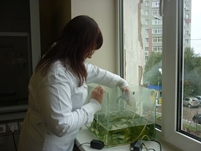The esoteric oarfish made its presence public on two separate occasions, at two separate Southern California beaches and in less than one week. The first, an 18-foot body, was found dead October 13, 2013 floating near Tayon Bay on California’s Catalina Island. The second, a 14-footer, was found washed ashore October 18 on an Oceanside beach. The distance between the two California beaches is approximately 50 nautical miles.
A researcher from Texas A&M University has simplified the task of counting shellfish by creating a cellphone app that uses GPS, making tracking over-harvested populations of the species simpler than ever. The app may one day help scientists track other marine life.

Why drilling mud is an essential component of the drilling process.

The Samara State Technical University research involves water phytoremediation with the use of Myriophyllum Verticillatum.
- By Alina Kopnina, Olga Zavodskaya
The rufa red knot, a shorebird the size of a robin, has been listed as a threatened species under the Endangered Species Act. The U.S. Fish and Wildlife Service made the announcement on Friday, September 27.
Recent IPCC report sites human influence cause of global warming
Whether or not the federal Bureau of Land Management will drill into The San Rafael Swell - a prized geological formation in Utah - remains an area of strong concern.

What causes soil pollution, concerns associated with it, and what can be done to regulate it.
Scientists used satellite data and climate model to dispel prior assumptions that Antartic ice melt caused primarily from iceberg calving.
A new research study discovered that tropical trees can fix themselves by capturing nitrogen from the air after being logged.

In a word, the key to future biofuel development stinks.
The two organizations sponsor a $2 million competition aimed at saving our oceans.
To prevent a spillover and possible flooding, Florida takes extreme measures.
Forest rangers and biologists placing sprinklers around sequoias threatened by Rim Fire likely serves public opinion more than trees.
EPA issues new label guidelines for pesticides and "bee-friendly" plants kill more bees.
Maritime New Zealand filed a total of three charges against Sanford Limited after investigating allegedly illegal dumping of oil into the sea of New Zealand’s Exclusive Economic Zone from the Korean foreign charter fishing vessel Pacinui.
Eighty of them were nominated by the California Department of Fish and Wildlife and the other two by the National Park Service.
The levy has been increased for the first time in 15 years to ensure the country has sufficient resources and equipment to respond to a major oil spill.
EPA has proposed permits that would allow oil companies to continue releasing contaminated wastewater onto the Wind River Reservation in central Wyoming.
The USGS has conducted a new study to determine the contaminant vulnerability of public-supply wells around the country, and also to discover which pollutants in an aquifer will make their way into those wells.